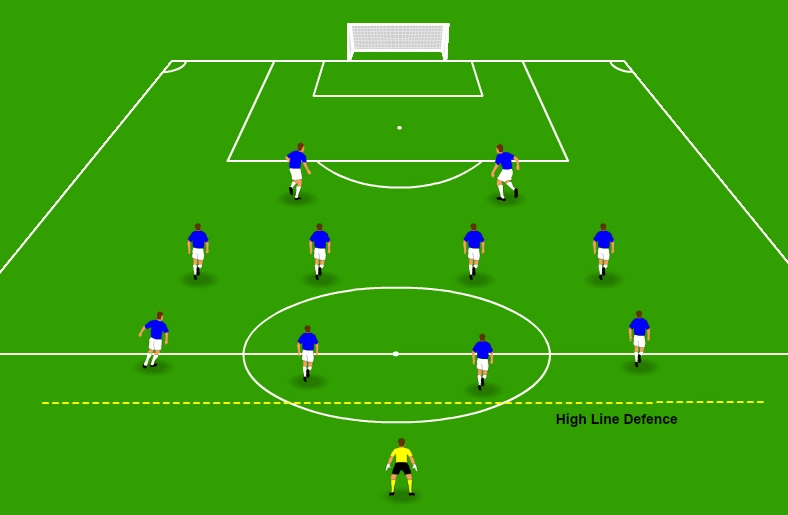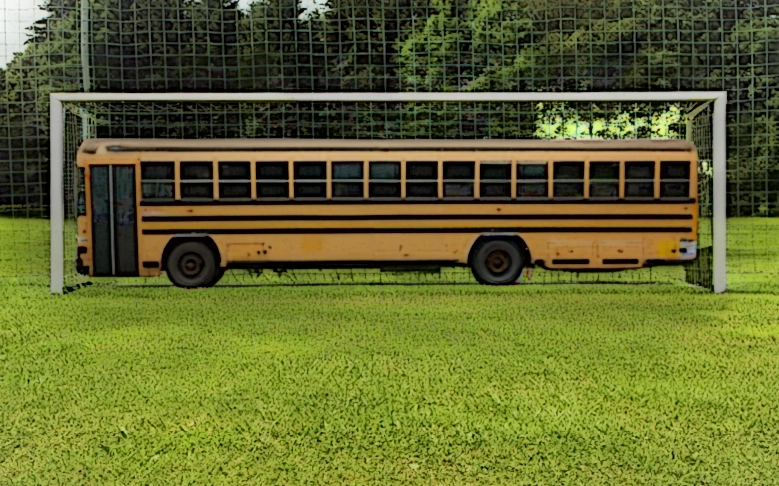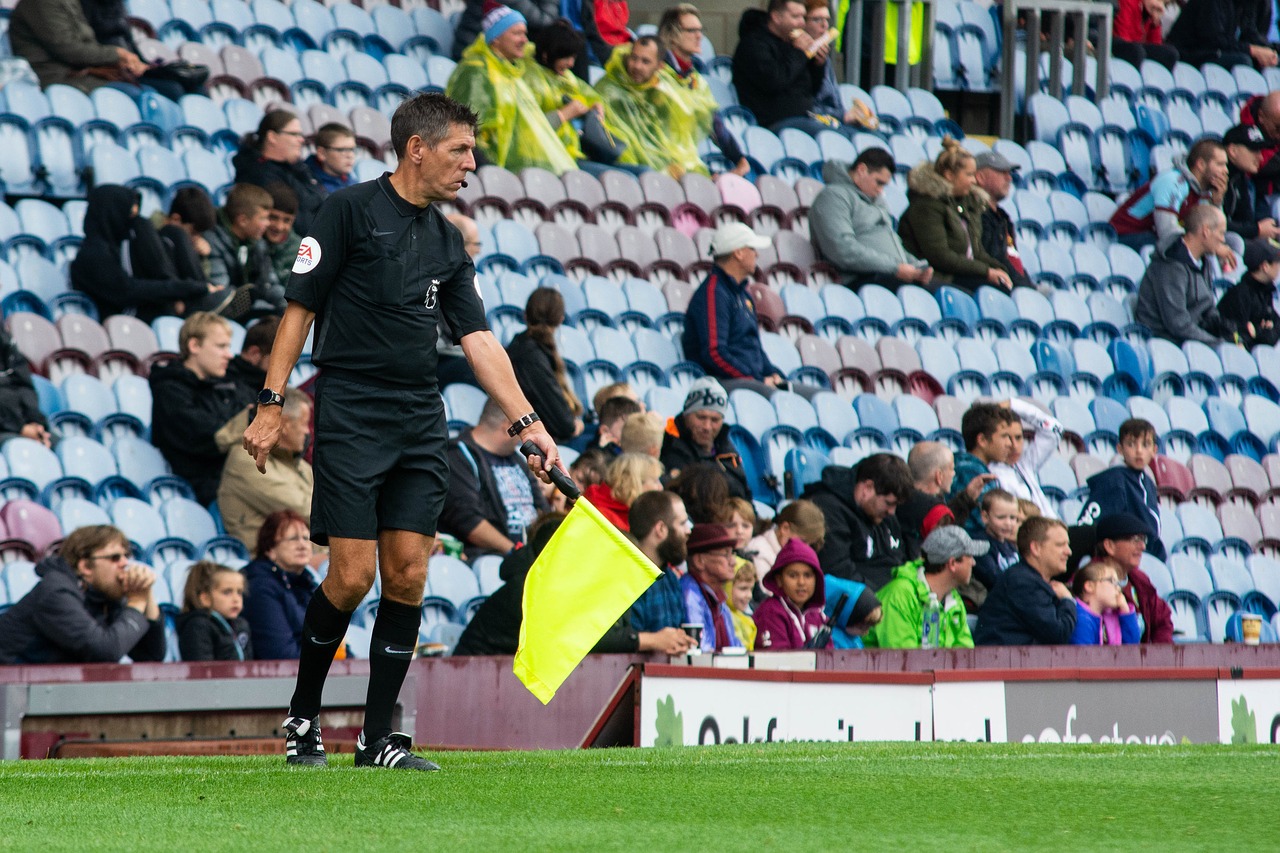What is a high line in football? Should my team use it?

Having a plan to recover the ball is as important as keeping possession. Teams usually choose a defensive tactic that they feel comfortable with and stick to it. A tactic used by modern offensive football teams is the high line defence.
A high line in football is a tactic in which defensive players stay close to the middle of the pitch when their team is in possession of the ball. Because defenders stay higher up in the field, the opposition’s offensive players must move to the middle of the park to avoid the offside trap. Therefore, reducing spaces and keeping the opposition away from the defending team’s goal.
Although the tactic focuses on the position of the defenders and defensive midfielders, it does not mean that the high line is exclusively used by defensive teams. Quite the contrary, the strongest and most offensive teams often use it. However, it is a risky strategy that requires a lot of coordination and practice.
When to use a high line in football
There are many scenarios and reasons for using a high line defence in football. The most common reason to use this tactic is to keep the opposition as far away as possible from the goal. The closer an attacking team is to the goal, the more chances to score they can create. For example, if a team sits back to defend, the opposition fullbacks can repeatedly run through the sideline and throw high balls into the box. The latter is often seen during the last minutes of a game when a team only needs a goal to draw, and the winning team decides to sit back.
A high line is also used when a team decides to pressure high on the pitch. In this tactic, attacking players close down on the opposition defenders. However, if only the offensive players apply pressure, the team will leave a gap in the midfield that the opposition can exploit. So, by pushing the backline to the middle of the field, the midfield has to move forward, the team becomes “shorter”, and no gaps are left in the middle.
Another scenario in which a high line is a good option is when the team’s defensive players are not that tall, and the opposition has strong and tall attacking players. This situation is a common occurrence in the context of amateur teams where also their goalkeepers may not be that tall. Then, a team with small players that sit back in defence is not a good combination. The opposition will throw ball after ball into the box to score goals from headers or clumsy penalties. If the defending team gets lucky and doesn’t concede a goal, they will finish the game with players injured or unable to play the following weekend. So, keeping the ball away as possible from their goal should be their priority. The high line defence is not exclusive to big teams.
The previous paragraphs give the impression that only offensive football teams with great players use a high line defence. However, that is not necessarily the case. One of the first professional teams to use the high line in professional football was Estudiantes de La Plata during the late 60s and early ’70s. They were a minor Argentine team, but the club changed forever when Osvaldo Zubeldia took as a coach. By combining high line and high pressing, and a level of fitness and tactical coordination not seen in those days, a team of otherwise average players became three times Libertadores champion and beat Manchester United at the Intercontinental Cup.
Nowadays, almost every football team use the high line defence as a tactic. Some teams use it constantly as part of their strategy. Others do it occasionally during some passages of the game.
Are high press and high line tactics the same?
Unfortunately, many football magazines and websites don’t seem to understand the difference between a high line and a high press. Usually, a high line goes together with pressing high, but these tactics are not the same, and you can use one and not the other.
A high pressing tactic involves attacking players putting under pressure the opposition defenders to recover the ball close to the opposition’s goal. However, your defenders do not necessarily need to move high on the pitch. It is not advisable, though, as you want to have your team “short” and playing as a block to avoid gaps in the middle of the park. That is why high line and high press are often confused; it is preferable to use them together.
Nevertheless, there are situations where you may still want to play a high line but not necessarily apply pressure high on the pitch. High pressing requires your creative and offensive player to be willing to defend. Unfortunately, offensive players often do not like to fulfil defensive duties (particularly in amateur football). In addition, applying pressure requires great conditioning and can exhaust your offensive players. So, you may not want to use high pressure but still play a high line to keep the opposition as far away as you can from your goal.
Strengths and weaknesses of the high line
Teams at all levels should understand how the high line works and its pros and cons, either to apply it as part of their game plan or to exploit the high line weaknesses when playing against a team that uses it. So, let’s see some of the pros and cons of using a high line defence in football:
Strengths
- Limits opposition space to manoeuvre.
- Keep offensive players away from the goal.
- The ball can be recovered higher on the pitch.
Weaknesses
- Leaves plenty of space behind the defence.
- If an opposition player breaks the offside trap, they will be one on one against the goalkeeper.
- Fast offensive players can be a nightmare for the defence.
- It must be combined with a high press to be more effective.
Then, to maximise the tactic strength and minimise its weaknesses, you must practice it and have the right skills in your team. For example, a goalkeeper should practice when to come out of the penalty box to reduce spaces. But first, your goalkeeper must be comfortable playing with their feet and able to read the game. We expand further on the skills required in the following section.
Skills a team must have to play a high line.
While most professional football teams use a high line defence, this is not necessarily the case for Sunday league teams. Playing this tactic requires skills that players in amateur teams may not have. In addition, the high line requires practice, and players need to know each other well. These are some of the skills a team must have to implement the high line successfully:
- Good communication. A quiet team is not a team. In a team, players must alert their teammates about dangerous situations. For example, if someone stays behind the line providing an opposition player space to move, their teammates must tell them. Therefore, communication is crucial to play the high line.
- A leader in the backline. Usually, a centre back leads the backline and coordinates the high line. For example, they will shout “push up” to indicate the defence to move up in the field. So, one of your centre backs needs to have the qualities of a leader. Read “5 attributes every centre back must have” to learn what you should expect from your centre backs.
- Experience defenders that understand the game. Playing the high line requires the defenders to know the game well, particularly the offside rule. Your leading centre back will constantly scan the field for opposition players and command the team to move up at the right time. They will also know when to do the opposite, to hold back. Again, experience is critical to making these decisions.
- Fast defenders. The high line is a risky strategy. If an opposition player breaks through your defensive line, they will have a direct run to the goal with plenty of time and space to finish one on one against the goalkeeper. Therefore, you need fast defenders that can chase and tackle any opposition player that breaks through.
- A sweeper goalkeeper. When playing the high line, the goalkeeper must move forward outside the box to reduce the space with the last defender of their team. If a long ball breaks through the defence, they must intercept it before the opposition gets to it. The goalkeeper effectively becomes an additional defender.
- Offensive players willing to help. As we mentioned before, the high line is often used with a high press. So, offensive players are expected to press the opposition defence. Even if a team doesn’t play high press, their attack should make it difficult for the opposition to launch a counterattack by kicking the ball over the backline. Therefore, the attacking players must be willing to defend (often not the case in amateur teams).
Should you use a high line in amateur football
As discussed, the high line defence is popular among professional teams. However, this blog is dedicated to amateur players and teams. So, should an amateur/Sunday league team use it? As you can guess, the answer is “it depends”.
To apply the high line in a game, you need to consider your team’s skills and how often your defence trains or plays together. If you had to choose one skill from those listed above, an experienced centre back with strong personality should be your priority. This player will organise the backline and act as an in-field coach by shouting instructions to the defence and midfield. If your team doesn’t have a player who can fulfil this role, the high line may not suit your team.
As mentioned above, the high line works better with a high press. So, the other trait required is to have players with a decent level of fitness. There should be at least enough fit players in the team to compensate for those that are not that fit. You won’t apply the pressure that professional teams use at the amateur level, but it helps if your front-men and the midfield stop the opposition players from kicking long balls behind the defence. To do the latter requires more than walking the park. So, if the level of fitness of your players is not great, or you don’t have enough subs to roll, the high line defence may not work for your team.
Finally, experience and how well your defensive players know each other are crucial. You will fail if you apply the high line defence in a novice football team or with players who played other football codes that don’t have offside. Playing with the offside rule requires experience. Not all your players need to be experienced, but you need a couple to guide those that are not. Then, how well players know each other is also essential. Players can only get to know each other through training or playing game after game together. So, do not bother with the high line if you have a different backline every weekend.
If you don’t train during the week, or your defence is not experienced enough, do not attempt using the high line. You will suffer for it.



